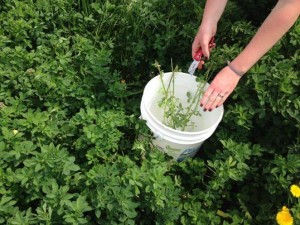Fruit:
- Only a few codling moths were caught in traps the week of May 4-8. No biofix date has been set at this time. Growers are being advised to begin fungicide sprays for the prevention of apple scab and powdery mildew.
- Oriental fruit moth pheromone traps were set in orchards the week of May 4-8. Growers are being advised to start a fungicide spray program for prevention of brown rot and powdery mildew.
- Strawberries are in bloom and scouts are noting damage to older blooms from an earlier frost event. Some plants are showing symptoms of possible black root rot or red stele. Growers are being advised to maintain a fungicide spray program for control of leaf diseases, anthracnose and powdery mildew.
- Grapes were at the ½ inch green stage the week of May 4-8. Growers are being advised to prepare for an early season fungicide spray program for control of black rot, phomopsis cane blight and powdery mildew.
- Brambles: Scouts found the lesser carpenter bee working in and burrowing into the pruned ends of brambles.
Vegetables:
- Scouts noted that some growers were not prepared for the summer temperatures in the 80’s that occurred the week of May 4-8. A number of plantings needed to be watered and growers were advised to open up row covers on vegetable crops planted into black plastic.
- Most high tunnel tomatoes looked good and were growing well. Scouts did find one high tunnel with plants showing symptoms of fusarium crown and root rot.
- Onions and garlic are looking good, some plants with yellow tips as a result of earlier damage by cold temperatures
- A few early stage slugs were found in cabbage.
- Asparagus beetles are active on asparagus and growers are being advised to treat.
- Other vegetable crops noted by scouts in grower fields include peas, summer squash, melons, cucumbers, peppers, green snap beans and sweet corn.
Agronomic Field Crops:
- Alfalfa: scouts are finding first and second instar alfalfa weevil larvae in fields. Most fields are well below the economic treatment level, but one field did have numbers close to threshold. Many fields were between 16 and 18 inches in height the week of May 4-8. At these heights, even if weevil larvae were detected at threshold levels, the recommendation is to consider an early harvest. When scouting for weevil take 10 stem samples, turn the plants upside down in the bucket and beat it against the sides. Count the larvae in the bucket and any left on the tips of the alfalfa. (See photos below) For more information visit: Alfalfa Weevil on Alfalfa, OSU Extension fact sheet
- Corn: A lot of corn was planted the week of May 4-8. Given the temperatures the week of May 4-8, most of that planting should be emerging the week of May 11-15. Corn planted at the end of April was just spiking through the soil surface in a couple of fields.
Photos by Rory Lewandowski, Extension Educator, Wayne County



Scouting for alfalfa weevil (1)